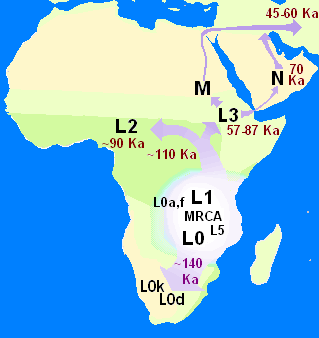
In human genetics, the Mitochondrial Eve is the matrilineal most recent common ancestor (MRCA) of all living humans. In other words, she is defined as the most recent woman from whom all living humans descend in an unbroken line purely through their mothers and through the mothers of those mothers, back until all lines converge on one woman.

The John Innes Centre (JIC), located in Norwich, Norfolk, England, is an independent centre for research and training in plant and microbial science founded in 1910. It is a registered charity grant-aided by the Biotechnology and Biological Sciences Research Council (BBSRC), the European Research Council (ERC) and the Bill and Melinda Gates Foundation and is a member of the Norwich Research Park. In 2017, the John Innes Centre was awarded a gold Athena SWAN Charter award for equality in the workplace.

Laboratory robotics is the act of using robots in biology, chemistry or engineering labs. For example, pharmaceutical companies employ robots to move biological or chemical samples around to synthesize novel chemical entities or to test pharmaceutical value of existing chemical matter. Advanced laboratory robotics can be used to completely automate the process of science, as in the Robot Scientist project.
This timeline of the history of the scientific method shows an overview of the development of the scientific method up to the present time. For a detailed account, see History of the scientific method.
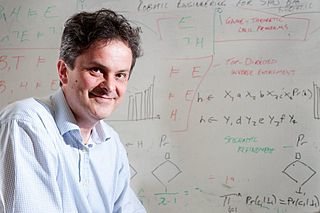
Stephen H. Muggleton FBCS, FIET, FAAAI, FECCAI, FSB, FREng is Professor of Machine Learning and Head of the Computational Bioinformatics Laboratory at Imperial College London.
Angela M. Belcher is a materials scientist, biological engineer, and the James Mason Crafts Professor of Biological Engineering and Materials Science at the Massachusetts Institute of Technology (MIT) in Cambridge, Massachusetts, United States. She is director of the Biomolecular Materials Group at MIT, a member of the Koch Institute for Integrative Cancer Research, and a 2004 MacArthur Fellow. In 2019, she was named head of the Department of Biological Engineering at MIT. She was elected a member of the National Academy of Sciences in 2022.

Chief Sci
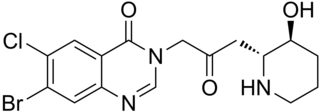
Halofuginone, sold under the brand name Halocur, is a coccidiostat used in veterinary medicine. It is a synthetic halogenated derivative of febrifugine, a natural quinazolinone alkaloid which can be found in the Chinese herb Dichroa febrifuga. Collgard Biopharmaceuticals is developing halofuginone for the treatment of scleroderma and it has received orphan drug designation from the U.S. Food and Drug Administration.

David John Nutt is an English neuropsychopharmacologist specialising in the research of drugs that affect the brain and conditions such as addiction, anxiety, and sleep. He is the chairman of Drug Science, a non-profit which he founded in 2010 to provide independent, evidence-based information on drugs. Until 2009, he was a professor at the University of Bristol heading their Psychopharmacology Unit. Since then he has been the Edmond J Safra chair in Neuropsychopharmacology at Imperial College London and director of the Neuropsychopharmacology Unit in the Division of Brain Sciences there. Nutt was a member of the Committee on Safety of Medicines, and was President of the European College of Neuropsychopharmacology.
Andrew Balmford is a professor of conservation science at the University of Cambridge. His research focuses on planning conservation, comparing the costs and benefits of conservation and how conservation can be reconciled with other activities.
Stephen George Oliver is an Emeritus Professor in the Department of Biochemistry at the University of Cambridge, and a Fellow of Wolfson College, Cambridge.

Ross Donald King is a Professor of Machine Intelligence at Chalmers University of Technology.
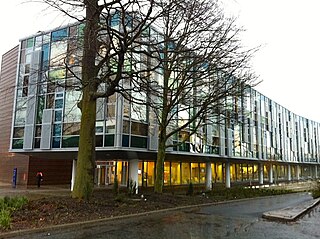
The Roslin Institute is an animal sciences research institute at Easter Bush, Midlothian, Scotland, part of the University of Edinburgh, and is funded by the Biotechnology and Biological Sciences Research Council.
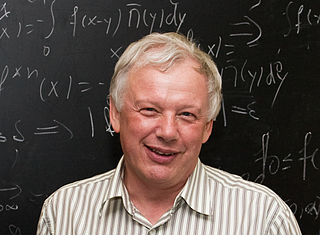
David S. Broomhead was a British mathematician specialising in dynamical systems and was professor of applied mathematics at the School of Mathematics, University of Manchester.
Ann C. Palmenberg is a professor of virology and biochemistry at the University of Wisconsin-Madison. She received her B.S. from St. Lawrence University and her Ph.D. from the University of Wisconsin-Madison. Dr. Palmenberg has been given numerous awards for her research and involvement within the scientific community, such as Fellow for the American Academy of Microbiology. News articles have been published about her work within virology, including an article in the Milwaukee Journal Sentinel on her findings on the common cold.

RU-59063 is a nonsteroidal androgen or selective androgen receptor modulator (SARM) which was first described in 1994 and was never marketed. It was originally thought to be a potent antiandrogen, but subsequent research found that it actually possesses dose-dependent androgenic activity, albeit with lower efficacy than dihydrotestosterone (DHT). The drug is an N-substituted arylthiohydantoin and was derived from the first-generation nonsteroidal antiandrogen (NSAA) nilutamide. The second-generation NSAAs enzalutamide, RD-162, and apalutamide were derived from RU-59063.
A discovery system is an artificial intelligence system that attempts to discover new scientific concepts or laws. The aim of discovery systems is to automate scientific data analysis and the scientific discovery process. Ideally, an artificial intelligence system should be able to search systematically through the space of all possible hypotheses and yield the hypothesis - or set of equally likely hypotheses - that best describes the complex patterns in data.
Emma Byrne is a contemporary British writer and scientist, working in the fields of swearing, artificial intelligence and robotics.
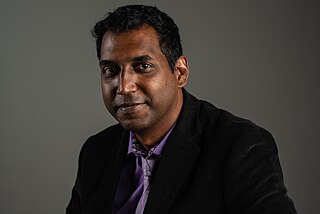
S. Joshua Swamidass is an American computational biologist, physician, academic, and author. He is an associate professor of Laboratory and Genomic Medicine, and a Faculty Lead of Translational Bioinformatics in the Institute for Informatics at Washington University in St. Louis.
A cloud laboratory is a heavily automated, centralized research laboratory where scientists can run an experiment from a computer in a remote location. Cloud laboratories offer the execution of life science research experiments as a service, allowing researchers to retain full control over experimental design. Users create experimental protocols through a high-level API and the experiment is executed in the cloud laboratory, with no need for the user to be involved.











